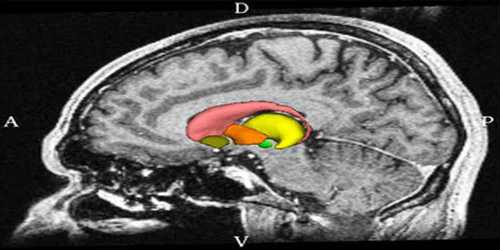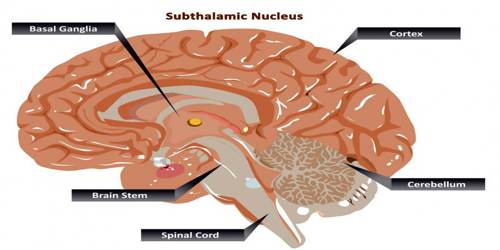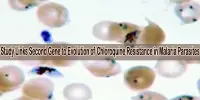Subthalamic Nucleus
Definition
Subthalamic nucleus is a circumscript nucleus that is located in the ventral part of the subthalamus, receives a massive projection from the lateral segment of the globus pallidus, and projects to both pallidal segments and to the mesencephalic tegmentum. In terms of anatomy, it is the major part of the subthalamus. As suggested by its name, the subthalamic nucleus is located ventral to the thalamus. It is also dorsal to the substantia nigra and medial to the internal capsule.

It was first described by Jules Bernard Luys in 1865, and the term corpus Luysi or Luys’ body is still sometimes used.
The subthalamic nucleus receives its main input from the lateral pallidum (external segment of the globus pallidus). Excitatory, glutamatergic inputs come from the cerebral cortex (particularly the motor cortex), and from the pars parafascicularis of the central complex. There are also neuromodulatory inputs from the substantia nigra pars compacta.
Structure and Functions of Subthalamic Nucleus
Subthalamic nucleus is the large nucleus of the subthalamus, which is anatomically a part of the diencephalon. The dendritic arborizations are ellipsoid, replicating in smaller dimension the shape of the nucleus. The dimensions of these arborizations (1200,600 and 300 μm) are similar across many species, including rat, cat, monkey and human, which is unusual.
It is functionally considered a part of the basal ganglia. It receives projections from the globus pallidus, the cerebral cortex, the substantia nigra, and the reticular formation of the pons. The subthalamic nucleus sends projections to the globus pallidus and the substantia nigra. The neurons of this nucleus use an excitatory neurotransmitter, glutamate. The neurons of the subthalamic nucleus are, in normal motor function, usually inhibited from firing by thalamic override.

The number of neurons increases with brain size as well as the external dimensions of the nucleus. The principal neurons are glutamatergic, which give them a particular functional position in the basal ganglia system. In humans there are also a small number (about 7.5%) of GABAergic interneurons that participate in the local circuitry; however, the dendritic arborizations of subthalamic neurons shy away from the border and majorly interact with one another.
Input to the basal ganglia is generally considered to be through the caudate nucleus and the putamen, that is, the striatum. Received here are afferents from all four lobes of the cortex, thalamic nuclei, and part of the substantia nigra (the pars compacta). The output fibers of the basal ganglia usually are from the globus pallidus and another part of the substantia nigra (the pars reticulata). The output of these structures usually is projected to certain thalamic nuclei, the brainstem reticular formation, the superior colliculus, and cortical motor areas in the frontal lobe.
The axons of its neurons leave the nucleus dorsally. The efferent axons are glutamatergic and most of the subthalamic principal neurons are directed to the other elements of the core of the basal ganglia. Some send axons to the substantia nigra medially and to the medial and lateral nuclei of the pallidum laterally (3-target, 21.3%). Some are 2-target with the lateral pallidum and the substantia nigra (2.7%) or the lateral pallidum and the medial (48%). Less are single target for the lateral pallidum.
Physiology of Subthalamic Nucleus
Several recent studies have focused on the autonomous pacemaking ability of subthalamic neurons. These cells are often referred to as “fast-spiking pacemakers”, since they can generate spontaneous action potentials at rates of 80 to 90 Hz in primates. Strong reciprocal connections link the subthalamic nucleus and the external segment of the globus pallidus. Both are fast-spiking pacemakers. Together, they are thought to constitute the “central pacemaker of the basal ganglia“v with synchronous bursts.
Some axons from the lateral pallidum go to the striatum. The activity of the medial pallidum is influenced by afferences from the lateral pallidum and from the subthalamic nucleus. The same for the substantia nigra pars reticulata. The subthalamic nucleus sends axons to another regulator: the pedunculo-pontine complex.
The lateropallido-subthalamic system is thought to play a key role in the generation of the patterns of activity seen in Parkinson’s disease.
Reference:
















